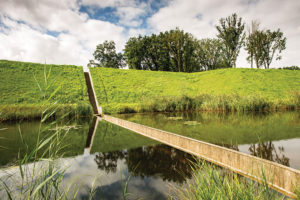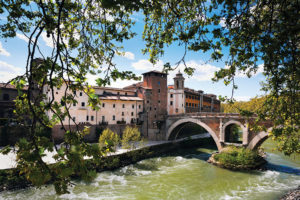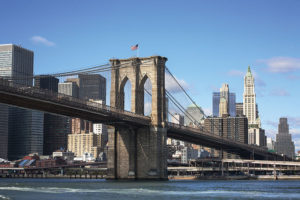Taking the Bridge-Building Prize
For centuries, bridges and other structures were big, bulky, visually disruptive hulks. Stone, iron, and concrete made them symbols of strength and stability. Solid construction helped people feel more confident about crossing or entering them.
Over time, they became lighter and more transparent. Innovative designs leveraging glass, plastic, cable, and sometimes environmentally-friendly recycled refuse replaced more solid materials to create bridges and buildings that are light, airy, beautiful – and stronger than their predecessors.
What led to these enhancements? The fact that beauty lies in the eye of the beholder. Designers and engineers are never satisfied with what they see and are always imagining the future. Let’s look at some notable historic bridges that took the industry to the next level, and a few of the exciting designs currently on drawing boards that could propel it into the future.
Bridges with Brawn
Back when bridge construction was a novel concept, builders understood few basic engineering concepts. They knew that the load placed on the surface of a bridge had to be distributed to support structures. To compensate for the lack of more sophisticated scientific or engineering knowledge, designers naturally turned to bulk to enhance the strength of their structures.
Over time, simple plank bridges, even hefty ones, proved to be ineffective, especially over vast expanses. Arch bridges were far more durable. The first ones were dense and heavy. Eventually, builders found ways to make them lighter, more attractive, and better integrated into their environments. Three of the oldest arch bridges in existence illustrate this progression.
Although it cannot be officially dated, the Arkadiko Bridge, located on the Peloponnesus in Greece, is believed to be the oldest arch bridge still in use. Dating from the Greek Bronze Age (3200-1050 B.C.), its heavy-duty design is a testament to its age and the primary reason for its longevity.
The Caravan Bridge is the world’s oldest reliably dated bridge, going all the way back to 850 B.C. It is a stone arch span over the Meles River in Izmir, Turkey. Clearly, bridge designers had made strides to improve functionality, design, and environmental integration.
The Pons Fabricius has connected Tiber Island to the heart of Rome since 62 B.C., the oldest bridge in the ancient city. It includes two broad arches, supported by a central pillar featuring a smaller arch built of ancient volcanic rock with brick and marble facing. Almost 800 years of bridge-building experience enhanced its beauty and effectiveness.
Despite the strength and stability of these solid arch structures, they had limits. As cities grew and became more congested, newer bridges were needed that could function in densely-populated, interconnected urban environments.
Early Innovators
As a next step, bridge builders turned to the emerging worlds of science and technology to find innovations to lighten, lengthen, and increase the strength of the bridges they built. Thought leaders like Leonardo da Vinci came up with designs that imagined what a bridge could be in fresh new ways. However, like many scientific experiments, some failed during, or shortly after, construction.
The Brooklyn Bridge was destined to be an engineering and design marvel from the day ground was broken in 1869. It is one of the oldest combined cable-stay suspension bridges, having survived more than 130 years under grueling vehicular, pedestrian, and train traffic. The cutting-edge design and new construction methods led to many injuries and deaths from decompression sickness (“the bends”) and other causes. The key reason the bridge has survived when so many similar ones failed is that it was built to be four to six times stronger than it needed to be.
The Honeymoon Bridge crossed the Niagara River, connecting Niagara Falls, New York, to Niagara Falls, Ontario, from when it was completed in 1898 until 1938. It was an upper steel arch bridge that was considered stable, despite threats from its unique location and ice that formed in the winter. A great windstorm during the winter of 1938 pushed a record amount of ice against the abutments, causing the bridge to collapse.
The original Tacoma Narrows Bridge was a grand engineering experiment and renowned bridge failure. At the time of its construction in 1940, it was one of the longest and slenderest suspension bridges in the world. It crossed a challenging section of Puget Sound in Washington State. Winds in the sound caused the bridge to vibrate, even during construction, and the structure collapsed less than six months after it opened. The bridge is still referenced in textbooks as an example of why it is critical to avoid aeroelastic flutter.
The Present
Most people view today’s modern bridges as visual masterworks. They are stunning to look at and enhance the everyday travel experience. However, underlying these beautiful structures are amazing engineering enhancements that make them stronger and safer than those built in earlier eras.
The Chords Bridge has completely transformed the skyline in Jerusalem. This almost invisible, crystal-like structure was modeled on the concept of David’s lyre. It is a major rapid transit link that carries trains and pedestrians in a glass-sided structure. An innovative side-spar cable-stayed design allows the bridge to flow in a graceful curve, keeping it visually light, yet incredibly strong and stable.

Moses Bridge, Halsteren, The Netherlands. Built in 2010. (By Digital Eye [Own work] CC BY-SA 4.0, via Wikimedia Commons)
Everything that makes the design of the Kurilpa Bridge in Australia so light and attractive also makes it robust and stable. It is a multiple-mast, cable-stay structure based on advanced principles of tensegrity. This produces a solid synergy between balanced tension and compression components. The dazzling light show that makes the bridge so stunning at night is powered by a solar grid that contributes excess power to the city of Brisbane.
The Futurists
What do bridge designers envision for the future? Much like the rest of the art and design world, they are creating structures that break all the rules – or combine them in new and innovative ways. This could lead to structures that are lighter, more beautiful and stronger than ever. In today’s environmentally-sensitive world, many are turning trash into structural treasures.
The basic plank bridge could get new life with new technology. It could be resurrected in the planned Econtainer Bridge that will connect Route 461 to Ariel Sharon Park in Israel. The park brings harmony to the urban landscape and nature, so this sustainable design made of used shipping containers is perfect for the site. The design even includes photovoltaic solar cells that will light the bridge and surrounding area at night, combining the most ancient of bridge structures with the latest environmentally-friendly concepts.
The Art Bridge is planned as a connector across the Los Angeles River, as well as a commentary on this famous body of water. Another plank design, the bridge will mostly be built from reinforced river trash, including bottle glass, cans, recycled tires, scrap metal, and more. Bridge lighting will be done in a completely environmentally friendly way. The brutal design is a reflection on the history and current state of the river, which has been significantly altered from its natural state.
This concept for a new London Bridge takes bridge design to a higher level. Not only will people cross it, but they can also live, farm, and shop on it as well. The bridge becomes a completely environmentally friendly, self-contained universe. The complex, integrated, lighter-than-air concept will help ensure the survival of the structure should something unexpected happen.
The lesson to learn from all this? Bridge designers and engineers can never stop looking for new and innovative ways to build beautiful, strong structures. Technology has made it possible to build bridges that are lighter, stronger, and more sensitive to their environments. Beauty has always triumphed over brawn.▪


